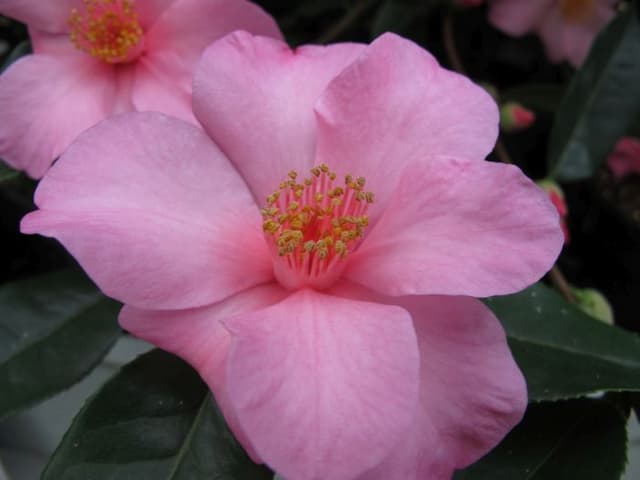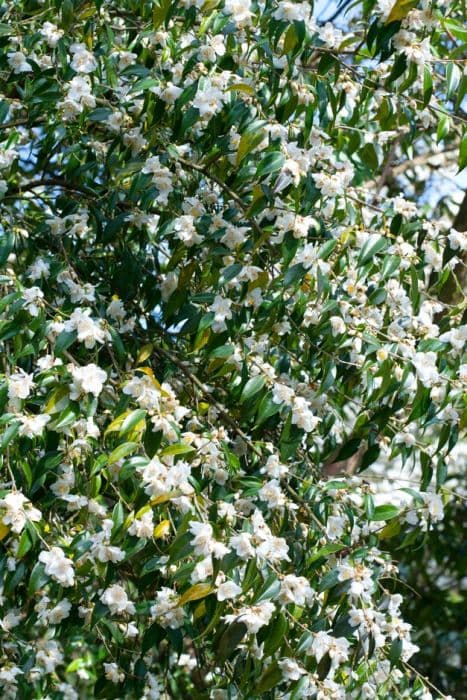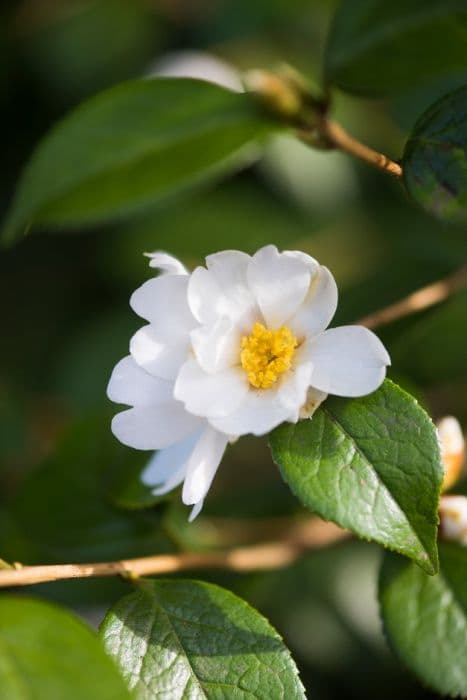Williamsii Camellia Camellia × williamsii 'E.t.r. Carlyon'

ABOUT
The plant named Camellia 'E.G. Waterhouse' is admired for its stunning flowers and glossy, evergreen foliage. The blooms are the highlight of this variety, showcasing an elegant form with double flowers that exhibit a refined blend of pink tones. Each petal is meticulously arranged in a concentric fashion, contributing to the flower's rich texture and luxurious appearance. The blossoms emit a subtle yet delightful fragrance that enhances the plant's overall allure. As for the foliage, it is comprised of dark green leaves that have a leathery feel to them. The leaves possess a high degree of shine, reflecting light off their surfaces, which adds a vibrant contrast against the softer hues of the flowers. This combination of striking flowers and lustrous leaves makes Camellia 'E.G. Waterhouse' especially prized in the garden for its aesthetic appeal and year-round interest.
About this plant
 Names
NamesFamily
Theaceae
Synonyms
Carlyon Camellia
Common names
Camellia × williamsii 'E.t.r. Carlyon'.
 Toxicity
ToxicityTo humans
The Williamsii camellia is generally considered to be non-toxic to humans. There are no significant symptoms of poisoning associated with this plant as it does not contain potent toxins harmful to people. Thus, ingesting parts of this plant typically does not lead to any serious consequences for human health.
To pets
The Williamsii camellia is also considered to be non-toxic to pets. It does not contain substances known to be poisonous to animals, so ingestion of this plant is not expected to cause significant symptoms of poisoning or serious health consequences for pets.
 Characteristics
CharacteristicsLife cycle
Perennials
Foliage type
Evergreen
Color of leaves
Green
Flower color
Pink
Height
6-10 feet (1.8-3 meters)
Spread
6-10 feet (1.8-3 meters)
Plant type
Shrub
Hardiness zones
7-9
Native area
East Asia
Benefits
 General Benefits
General Benefits- Aesthetic Appeal: Offers ornamental value with its large, showy flowers that enhance the beauty of gardens.
- Shade Tolerance: Able to grow in partial shade, making it versatile for different garden locations.
- Evergreen Foliage: Provides year-round interest with its glossy green leaves, even when not in bloom.
- Bee Attraction: Flowers attract bees, aiding in the pollination of surrounding plants.
- Low Maintenance: Generally requires little care once established, apart from occasional pruning and feeding.
- Cold Hardy: Resistant to cold, making it suitable for gardens in cooler climates.
- Variety of Uses: Can be used in garden beds, borders, or as a feature plant due to its attractive form.
- Long Blooming Season: Offers a long period of blooming, typically from late winter to early spring.
- Hybrid Vigor: As a hybrid, it may exhibit increased growth and improved resistance to disease.
 Medical Properties
Medical PropertiesThis plant is not used for medical purposes.
 Air-purifying Qualities
Air-purifying QualitiesThis plant is not specifically known for air purifying qualities.
 Other Uses
Other Uses- The tightly closed buds of Camellia × williamsii are sometimes used as natural decorations in floral design, offering a unique texture and appearance to arrangements.
- Camellia wood, being dense and hard, can be used for carving small decorative items or in the crafting of specialty tools and equipment.
- The leaves of the Camellia plant can occasionally be used to create a green dye for fabrics, although this is not a commonly practiced use.
- Camellia × williamsii, like other camellias, can be grown as a bonsai, providing a challenge to enthusiasts to shape and care for this plant in miniature form.
- The spent blooms and fallen leaves can be composted and used to enrich garden soil, contributing to the health of other plants in the garden.
- Camellia petals can be scattered on pathways or water features for a decorative effect during special occasions or garden parties.
- The plant can serve as a living privacy screen or windbreak when planted in a dense row due to its evergreen nature and dense foliage.
- In creative photography, the intricate flowers and glossy leaves serve as a beautiful backdrop for close-ups and macro photography.
- Camellia × williamsii's root system can be used for erosion control because it helps to hold the soil together on slopes.
- The flowers can be used to infuse oils with their fragrance for making naturally scented candles and potpourri, although it's more of a novelty due to the light scent.
Interesting Facts
 Feng Shui
Feng ShuiThe plant Camellia is not used in Feng Shui practice.
 Zodiac Sign Compitability
Zodiac Sign CompitabilityThe plant Camellia is not used in astrology practice.
 Plant Symbolism
Plant Symbolism- Adoration - Camellias are often associated with deep admiration and adoration towards someone.
- Perfection - Due to their lush and flawless blooms, they symbolize the idea of perfection or the aspiration towards it.
- Longevity - Camellias have a robust nature and long blooming season, representing the concept of long life and enduring presence.
- Divine Love - The beauty of their flowers often connects camellias with divine or unparalleled love.
- Loyalty - The plant is considered a sign of loyalty, referencing the faithful way it returns year after year.
- Gratitude - Giving camellias can represent a message of thanks or gratitude to another.
 Water
WaterWilliamsii camellias should be watered deeply to ensure moisture reaches the roots, usually about once a week. During the growing season in spring and summer, increase watering to keep the soil moist, aiming for 1 to 1.5 gallons depending on the size and age of the plant. Reduce watering in the fall and further in winter when the plant is dormant. Avoid watering the foliage directly to prevent fungal diseases, and always water at the base of the plant. Over-watering can lead to root rot, so let the soil dry slightly between waterings.
 Light
LightWilliamsii camellias flourish in partial shade with dappled sunlight. Avoid direct afternoon sun, which can scorch the leaves, but provide enough light to promote healthy growth and flowering. An ideal spot is under the high, open canopy of trees that allows filtered light or on the north side of a building where it will receive morning light and afternoon shade.
 Temperature
TemperatureWilliamsii camellias prefer moderate temperatures and thrive in zones 7 to 9. They can withstand minimum winter temperatures down to about 0 degrees Fahrenheit but perform best when the temperature range is between 50 to 70 degrees Fahrenheit. Protection from cold, drying winds in winter is crucial, and it's best to avoid planting in locations that experience severe temperature fluctuations.
 Pruning
PruningPrune Williamsii camellias to maintain shape and remove dead or weak growth, best done after flowering has finished in late winter or early spring. Light pruning annually encourages new growth and blooms. Remove any crossing branches or those that disrupt the plant's structure. Avoid heavy pruning, as camellias are slow to recover from severe cuts.
 Cleaning
CleaningAs needed
 Soil
SoilThe best soil mix for Williamsii Camellia is acidic, well-drained, and rich in organic matter. Use a blend of 2 parts peat moss, 1 part perlite, and 1 part pine bark fines. The ideal soil pH for Williamsii Camellia should be between 5.0 and 6.5.
 Repotting
RepottingWilliamsii Camellia should be repotted every 2-3 years or when it outgrows its current pot. Ensure proper drainage in the new container and use an acidic soil mix suited for camellias.
 Humidity & Misting
Humidity & MistingWilliamsii Camellia thrives in moderate to high humidity but is tolerant of lower levels. Aim for a humidity level between 40% and 60% for optimal growth and blooming.
 Suitable locations
Suitable locationsIndoor
Provide bright, indirect light with high humidity.
Outdoor
Plant in partial shade with shelter from wind, acid soil.
Hardiness zone
7-9 USDA
 Life cycle
Life cycleCamellia × williamsii 'E.t.r. Carlyon', commonly known as the Williamsii camellia, begins its life cycle with seed germination, which occurs in favorable conditions of warmth and moisture, ideally in spring. Following germination, the seedling grows into a small plant, establishing itself with a bushy growth habit characteristic of camellias. Over the years, the plant matures into a shrub or small tree, developing a sturdy structure and producing glossy, evergreen leaves. Flower buds form in late summer to autumn, overwintering on the plant, and blooming typically occurs from late winter to early spring, showcasing its stunning flowers. Once pollination has taken place, generally by insects such as bees, the flowers give way to seed pods that ripen and eventually release seeds to propagate the next generation. In cultivation, however, many gardeners propagate Williamsii camellias through cuttings or grafting to maintain the specific qualities of the cultivar.
 Propogation
PropogationPropogation time
Spring-Early Summer
The Camellia × williamsii 'E.t.r. Carlyon', commonly known as Williamsii camellia, is primarily propagated by semi-hardwood cuttings. This method is usually carried out in late summer or early fall. To propagate, a 4-6 inch (10-15 cm) cutting is taken from a healthy parent plant, cutting just below a leaf node. The lower leaves are removed, and the cut end dipped in rooting hormone to encourage root growth. The cutting is then placed in a pot filled with a mix of peat and perlite, ensuring the leaf node where the leaves were removed is buried. The soil should be kept moist but not waterlogged, and the pot placed in a warm area with bright, indirect light. Rooting can take several weeks, after which the rooted cutting can be transplanted into a larger pot or directly into the garden.









